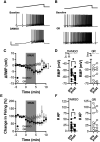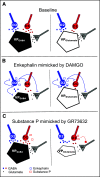Differential Modulation of GABAergic and Glutamatergic Neurons in the Ventral Pallidum by GABA and Neuropeptides
- PMID: 37414552
- PMCID: PMC10348443
- DOI: 10.1523/ENEURO.0404-22.2023
Differential Modulation of GABAergic and Glutamatergic Neurons in the Ventral Pallidum by GABA and Neuropeptides
Abstract
The ventral pallidum (VP) is an integral locus in the reward circuitry and a major target of GABAergic innervation of both D1-medium spiny neurons (MSNs) and D2-MSNs from the nucleus accumbens. The VP contains populations of GABAergic [VPGABA, GAD2(+), or VGluT(-)] and glutamatergic [VPGlutamate, GAD2(-), or VGluT(+)] cells that facilitate positive reinforcement and behavioral avoidance, respectively. MSN efferents to the VP exert opponent control over behavioral reinforcement with activation of D1-MSN afferents promoting and D2-MSN afferents inhibiting reward seeking. How this afferent-specific and cell type-specific control of reward seeking is integrated remains largely unknown. In addition to GABA, D1-MSNs corelease substance P to stimulate neurokinin 1 receptors (NK1Rs) and D2-MSNs corelease enkephalin to activate μ-opioid receptors (MORs) and δ-opioid receptors. These neuropeptides act in the VP to alter appetitive behavior and reward seeking. Using a combination of optogenetics and patch-clamp electrophysiology in mice, we found that GAD2(-) cells receive weaker GABA input from D1-MSN, but GAD2(+) cells receive comparable GABAergic input from both afferent types. Pharmacological activation of MORs induced an equally strong presynaptic inhibition of GABA and glutamate transmission on both cell types. Interestingly, MOR activation hyperpolarized VPGABA but not VGluT(+). NK1R activation inhibited glutamatergic transmission only on VGluT(+) cells. Our results indicate that the afferent-specific release of GABA and neuropeptides from D1-MSNs and D2-MSNs can differentially influence VP neuronal subtypes.
Keywords: GABA; medium spiny neurons; neuropeptides; optogenetics; ventral pallidumg; whole cell patch clamp.
Copyright © 2023 Neuhofer and Kalivas.
Figures







Similar articles
-
Loss of Plasticity in the D2-Accumbens Pallidal Pathway Promotes Cocaine Seeking.J Neurosci. 2017 Jan 25;37(4):757-767. doi: 10.1523/JNEUROSCI.2659-16.2016. J Neurosci. 2017. PMID: 28123013 Free PMC article.
-
Treadmill exercise training inhibits morphine CPP by reversing morphine effects on GABA neurotransmission in D2-MSNs of the accumbens-pallidal pathway in male mice.Neuropsychopharmacology. 2024 Oct;49(11):1700-1710. doi: 10.1038/s41386-024-01869-4. Epub 2024 May 7. Neuropsychopharmacology. 2024. PMID: 38714787
-
Sustained fentanyl exposure inhibits neuronal activity in dissociated striatal neuronal-glial cocultures through actions independent of opioid receptors.J Neurophysiol. 2024 Sep 1;132(3):1056-1073. doi: 10.1152/jn.00444.2023. Epub 2024 Aug 7. J Neurophysiol. 2024. PMID: 39110896 Free PMC article.
-
The Black Book of Psychotropic Dosing and Monitoring.Psychopharmacol Bull. 2024 Jul 8;54(3):8-59. Psychopharmacol Bull. 2024. PMID: 38993656 Free PMC article. Review.
-
Three paradoxes related to the mode of action of pramipexole: The path from D2/D3 dopamine receptor stimulation to modification of dopamine-modulated functions.J Psychopharmacol. 2024 Jul;38(7):581-596. doi: 10.1177/02698811241261022. Epub 2024 Jul 23. J Psychopharmacol. 2024. PMID: 39041250 Review.
References
MeSH terms
Substances
Grants and funding
LinkOut - more resources
Full Text Sources
Molecular Biology Databases
Research Materials
Miscellaneous
